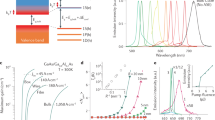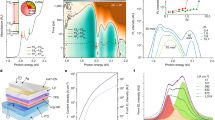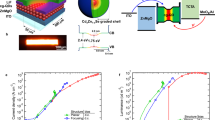Abstract
Chemically synthesized semiconductor quantum dots (QDs) can potentially enable solution-processable laser diodes with a wide range of operational wavelengths, yet demonstrations of lasing from the QDs are still at the laboratory stage. An important challenge—realization of lasing with electrical injection—remains unresolved, largely due to fast nonradiative Auger recombination of multicarrier states that represent gain-active species in the QDs. Here we present population inversion and optical gain in colloidal nanocrystals realized with direct-current electrical pumping. Using continuously graded QDs, we achieve a considerable suppression of Auger decay such that it can be outpaced by electrical injection. Further, we apply a special current-focusing device architecture, which allows us to produce high current densities (j) up to ∼18 A cm−2 without damaging either the QDs or the injection layers. The quantitative analysis of electroluminescence and current-modulated transmission spectra indicates that with j = 3–4 A cm−2 we achieve the population inversion of the band-edge states.
This is a preview of subscription content, access via your institution
Access options
Access Nature and 54 other Nature Portfolio journals
Get Nature+, our best-value online-access subscription
$29.99 / 30 days
cancel any time
Subscribe to this journal
Receive 12 print issues and online access
$259.00 per year
only $21.58 per issue
Buy this article
- Purchase on Springer Link
- Instant access to full article PDF
Prices may be subject to local taxes which are calculated during checkout





Similar content being viewed by others
References
Svelto, O. Principles of Lasers Vol. 1, 5 edn (Springer, 2010).
Klimov, V. I. et al. Optical gain and stimulated emission in nanocrystal quantum dots. Science 290, 314–317 (2000).
Landsberg, P. T. Recombination in Semiconductors (Cambridge Univ. Press, 1991).
Robel, I., Gresback, R., Kortshagen, U., Schaller, R. D. & Klimov, V. I. Universal size-dependent trend in Auger recombination in direct-gap and indirect-gap semiconductor nanocrystals. Phys. Rev. Lett. 102, 177404 (2009).
García-Santamaría, F. et al. Suppressed Auger recombination in “Giant” nanocrystals boosts optical gain performance. Nano Lett. 9, 3482–3488 (2009).
Nasilowski, M., Spinicelli, P., Patriarche, G. & Dubertret, B. Gradient CdSe/CdS quantum dots with room temperature biexciton unity quantum yield. Nano Lett. 15, 3953–3958 (2015).
Htoon, H., Hollingsworth, J. A., Dickerson, R. & Klimov, V. I. Effect of zero- to one-dimensional transformation on multiparticle Auger recombination in semiconductor quantum rods. Phys. Rev. Lett. 91, 227401 (2003).
Rabouw, F. T. et al. Reduced Auger recombination in single CdSe/CdS nanorods by one-dimensional electron delocalization. Nano Lett. 13, 4884–4892 (2013).
Lutich, A. A. et al. Multiexcitonic dual emission in CdSe/CdS tetrapods and nanorods. Nano Lett. 10, 4646–4650 (2010).
Cragg, G. E. & Efros, A. L. Suppression of Auger processes in confined structures. Nano Lett. 10, 313–317 (2010).
Bae, W. K. et al. Controlled alloying of the core–shell interface in CdSe/CdS quantum dots for suppression of Auger recombination. ACS Nano 7, 3411–3419 (2013).
Bae, W. K. et al. Controlling the influence of Auger recombination on the performance of quantum-dot light-emitting diodes. Nat. Commun. 4, 3661 (2013).
Park, Y.-S., Bae, W. K., Baker, T., Lim, J. & Klimov, V. I. Effect of Auger recombination on lasing in heterostructured quantum dots with engineered core/shell interfaces. Nano Lett. 15, 7319–7328 (2015).
Vaxenburg, R., Rodina, A., Lifshitz, E. & Efros, A. L. Biexciton Auger recombination in CdSe/CdS core/shell semiconductor nanocrystals. Nano Lett. 16, 2503–2511 (2016).
Park, Y.-S., Bae, W. K., Pietryga, J. M. & Klimov, V. I. Auger recombination of biexcitons and negative and positive trions in individual quantum dots. ACS Nano 8, 7288–7296 (2014).
Efros, A. L. et al. Band-edge exciton in quantum dots of semiconductors with a degenerate valence band: dark and bright exciton states. Phys. Rev.B 54, 4843–4856 (1996).
Norris, D. J. & Bawendi, M. G. Measurement and assignment of the size-dependent optical spectrum in CdSe quantum dots. Phys. Rev. B 53, 16338–16346 (1996).
Klimov, V. I. Multicarrier interactions in semiconductor nanocrystals in relation to the phenomena of Auger recombination and carrier multiplication. Annu. Rev. Condens. Matter Phys. 5, 285–316 (2014).
Vanmaekelbergh, D. et al. Shape-dependent multiexciton emission and whispering gallery modes in supraparticles of CdSe/multishell quantum dots. ACS Nano 9, 3942–3950 (2015).
Gollner, C. et al. Random lasing with systematic threshold behavior in films of CdSe/CdS core/thick-shell colloidal quantum dots. ACS Nano 9, 9792–9801 (2015).
Diaconescu, B., Padilha, L. A., Nagpal, P., Swartzentruber, B. S. & Klimov, V. I. Measurement of electronic states of PbS nanocrystal quantum dots using scanning tunneling spectroscopy: the role of parity selection rules in optical absorption. Phys. Rev. Lett. 110, 127406 (2013).
Dai, X. et al. Solution-processed, high-performance light-emitting diodes based on quantum dots. Nature 515, 96–99 (2014).
Kwak, J. et al. Bright and efficient full-color colloidal quantum dot light-emitting diodes using an inverted device structure. Nano Lett. 12, 2362–2366 (2012).
Lim, J. et al. Influence of shell thickness on the performance of light-emitting devices based on CdSe/Zn1−XCdXS core/shell heterostructured quantum dots. Adv. Mater. 26, 8034–8040 (2014).
Klimov, V. I. Optical nonlinearities and ultrafast carrier dynamics in semiconductor nanocrystals. J. Phys. Chem. B 104, 6112–6123 (2000).
Crooker, S. A., Barrick, T., Hollingsworth, J. A. & Klimov, V. I. Multiple temperature regimes of radiative decay in CdSe nanocrystal quantum dots: intrinsic limits to the dark-exciton lifetime. Appl. Phys. Lett. 82, 2793–2795 (2003).
Joshi, A., Narsingi, K. Y., Manasreh, M. O., Davis, E. A. & Weaver, B. D. Temperature dependence of the band gap of colloidal CdSe/ZnS core/shell nanocrystals embedded into an ultraviolet curable resin. Appl. Phys. Lett. 89, 131907 (2006).
Acknowledgements
V.I.K. and Y.-S.P. were supported by the Chemical Sciences, Biosciences and Geosciences Division, Office of Basic Energy Sciences, Office of Science, US Department of Energy. J.L. acknowledges support by the Laboratory Directed Research and Development program at Los Alamos National Laboratory.
Author information
Authors and Affiliations
Contributions
J.L. synthesized the QDs, designed the ‘current-focusing’ device architecture, and fabricated and characterized the QD-LEDs. Y.-S.P. conducted spectroscopic studies of the QDs and measurements of their lasing characteristics. J.L. and Y.-S.P. provided equal contributions to this study. V.I.K. initiated the studies, developed the correlated electron–hole injection model, and wrote the manuscript with contributions from other co-authors.
Corresponding author
Ethics declarations
Competing interests
The authors declare no competing financial interests.
Supplementary information
Supplementary Information
Supplementary Information (PDF 13223 kb)
Rights and permissions
About this article
Cite this article
Lim, J., Park, YS. & Klimov, V. Optical gain in colloidal quantum dots achieved with direct-current electrical pumping. Nature Mater 17, 42–49 (2018). https://doi.org/10.1038/nmat5011
Received:
Accepted:
Published:
Issue Date:
DOI: https://doi.org/10.1038/nmat5011
This article is cited by
-
Luminescent solar concentrator efficiency enhanced via nearly lossless propagation pathways
Nature Photonics (2024)
-
Synthesis and Modulation of Low-Dimensional Transition Metal Chalcogenide Materials via Atomic Substitution
Nano-Micro Letters (2024)
-
Heteroepitaxial chemistry of zinc chalcogenides on InP nanocrystals for defect-free interfaces with atomic uniformity
Nature Communications (2023)
-
Optical gain and lasing from bulk cadmium sulfide nanocrystals through bandgap renormalization
Nature Nanotechnology (2023)
-
Minimizing heat generation in quantum dot light-emitting diodes by increasing quasi-Fermi-level splitting
Nature Nanotechnology (2023)



